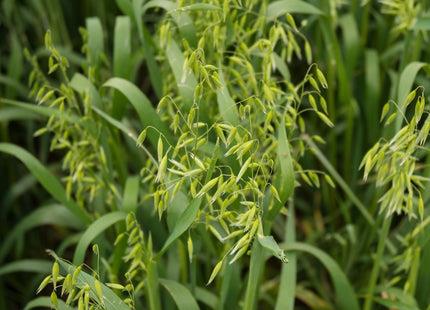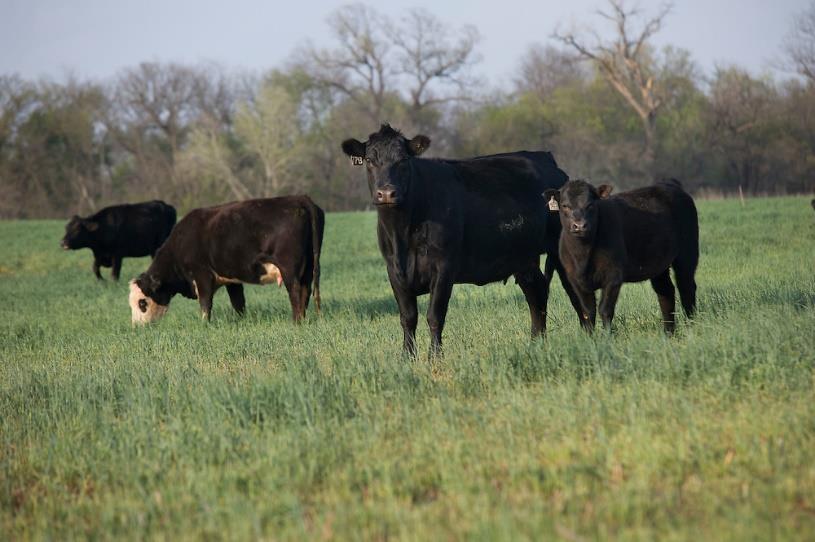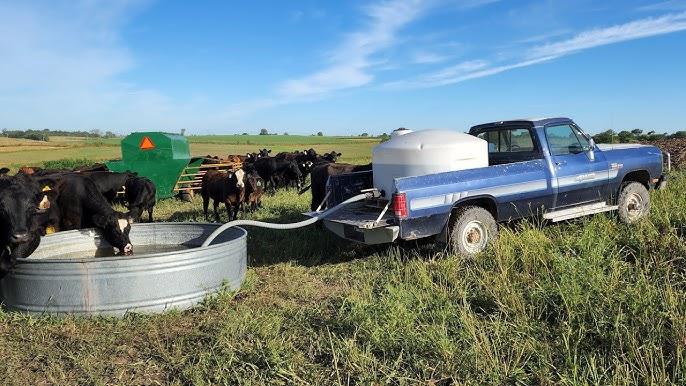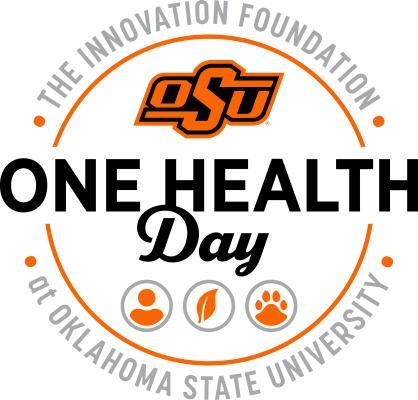Ag Insights November 2024
Friday, November 1, 2024
Spring-planted Oats
Josh Bushong, Area Extension Agronomist Spring-planted Oats
 Without a doubt, October this fall has been hot and dry. As a state, this October
will likely be the third driest since 1921 with all regions of the state likely to
rank top 5 (other than the Panhandle). The statewide average maximum air temperature
was between 4.6 to 12.1 degrees warmer through October, compared to the past 15 year
averages. Late sown wheat acres might be left open this winter.
Without a doubt, October this fall has been hot and dry. As a state, this October
will likely be the third driest since 1921 with all regions of the state likely to
rank top 5 (other than the Panhandle). The statewide average maximum air temperature
was between 4.6 to 12.1 degrees warmer through October, compared to the past 15 year
averages. Late sown wheat acres might be left open this winter.
Open fields this winter are prime candidates for a spring forage crop. Spring-planted oats can provide many possibilities for farmers. Typically in Oklahoma, oats are mainly grown for hay but they can also provide a quick grazing pasture that can bridge the gap until summer pasture is available or even provide cover for a summer crop. While oats can be grazed, the crop can’t handle intensive grazing as well as some of the dual-purpose varieties of wheat.
Typically, planting dates for Oklahoma are mid-February to mid-March. A minimum average daily soil temperature of 45 degrees is needed to avoid germination issues, but waiting until 50 degrees is reached would be more ideal. Sowing oats will be very similar to other small grains like wheat but oats are much lighter, about 32 lb/bu. Seeding rates range from 80 to 120 lb/A depending on planting conditions and seed costs. Conventionally tilled fields often will have better stand establishment and early seedling vigor, but direct seeding into no-till can still be adequate when previous crop residues are minimum.
Higher seeding rates are often beneficial to achieving forage production goals. Producers should note seed quality and adjust seeding rates accordingly. Ideally, germination rates should be higher than 85%. Spring planted oats usually will not tiller much, so adequate seeding rates can be critical to production from single-stemmed plants.
When selecting oat varieties, one characteristic to inquire about should be maturity. Short maturity oat varieties produce more grain. Medium and longer maturity oat varieties tend to yield more forage. Field research from Texas A&M Agrilife Extension confirmed these statements. Longer maturities were also preferred when used for one-time hay harvest.
Spring-planted winter oats will likely yield less forage than fall-sown winter wheat. Grazing forage production potential from spring-planted oats will average 1,500 to 2,000 pounds of forage per acre. Actual rates of nitrogen would be about 40 to 60 pounds to produce this amount of forage. Since oat seedlings are not as stress tolerant as wheat, it is recommended to wait until the crop is 6 to 8 inch tall before initiating grazing. About 35- to 60 days of grazing should be expected.
When laying down for hay, peak forage quality is reached once the crop reaches the boot growth stage. Harvesting between late boot and head emergence will optimize both tonnage and quality. Delaying harvest past head emergence may lead to more tonnage at the expense of quality, but windrows will dry down sooner. One field trial near Lubbock, TX looked at six hay timings from early boot to firm dough. At early boot the hay had 18.4% crude protein, at fully headed it was 13.9%, and at firm dough it was 8.7%. But the tonnage doubled from early boot to firm dough.
Field research from KSU conducted near Hutchinson, KS showed an average hay forage yield of 4 tons per acre amongst the 20 different varieties studied. These hay yields were obtained with 75 pounds of nitrogen applied preplant and an additional 50 pounds applied approximately six weeks after emergence.
If used for cover, seeding rates can be slightly reduced if the goal is to simply protect the soil from blowing. If the goal of the cover is to prevent soil water evaporation or even to shade out weeds, then seeding rates should not be reduced. If a summer crop is desired, producers need to terminate the oats once stems have elongated but before head development. The crop will start to use more water once it reaches the reproductive growth stages.
There are some broadleaf herbicide options for spring-planted oats. These include some Group 4 (Phenoxy/Auxin) products such as 2,4-D, dicamba, and MCPA, as well as some Group 2 (ALS) products such as Glean, Harmony (SG and Xtra), and Peak. Other broadleaf options include some pre-mixed products such as Bromoxynil 2 + 2,4-D, Wildcard Xtra, Carnivore, Orion, Sentrallas, Supremacy, and Trump Card. Unfortunately, there are not many herbicide options for grass control. Callisto is labeled for crabgrass control if it’s less than three inches. Callisto may result in temporary crop injury.
Producers wanting to learn more about spring-planted oats should contact their local OSU Extension office. More information can also be found in the OSU factsheet PSS-2160 “Spring-planted Oat for Grazing or Hay Production”.
Reference to commercial products or trade names is made with the understanding that no discrimination is intended and no endorsement by the Oklahoma Cooperative Extension Service is implied.
Tips for Health and Nutrition in Weaned Calves
Dana Zook, NW OK Area Livestock Specialist
 It’s the fall season again. Some ag producers might consider it wheat sowing season
or others harvest season. Some cattle producers might think of the fall as the time
to deal with illness in calves. Unfortunately, stress from weaning paired with the
fluctuating temperatures can cause an uptick in sickness in beef calves. Some sickness
is hard to avoid, but well-planned nutrition and preventive health measures make a
difference in preventing some illness. How do you set up calves for success? Read
on for some tips for health and nutrition for your fall calf crop this season.
It’s the fall season again. Some ag producers might consider it wheat sowing season
or others harvest season. Some cattle producers might think of the fall as the time
to deal with illness in calves. Unfortunately, stress from weaning paired with the
fluctuating temperatures can cause an uptick in sickness in beef calves. Some sickness
is hard to avoid, but well-planned nutrition and preventive health measures make a
difference in preventing some illness. How do you set up calves for success? Read
on for some tips for health and nutrition for your fall calf crop this season.
- Plan for weaning nutrition! Get a hay test now and work with your extension office to develop a nutrition plan targeted to the weight of your calves.
- Get to know your local veterinarian and develop a herd health plan before you have an issue. When calves are coming down with illness, a veterinarian can be your most valuable asset!
- Maintain a good record keeping system that works for your specific operation. Treatment records should include brand of vaccine, product type (vaccine, antibiotic, etc.), bottle size, expiration date, type of injection (SQ, IM, or IV) and person giving treatment.
- Purchase all vaccines and antibiotics from a reputable supplier. Time the purchase of all products as close to treatment as possible.
- Read and follow the label of all vaccines and antibiotics used. Maximize effectiveness of the product by using proper dosage according to animal weight (when possible) and interval of treatment.
- Store all vaccines and antibiotics at 35°F to 46°F, unless otherwise noted on the label. This should include during transport from supplier and during processing. A vaccine cooler can help keep vaccines at a constant temperature during travel or while using them chute side. OSU has good instructions for building your own vaccine cooler.
- Use needles that are new and the proper gauge for the product being used and animal being treated. Change needles every 10-15 head unless recommended by your vet. Never enter a vaccine bottle with a used needle.
- Use all modified live vaccines within 1 hour after reconstitution. Reconstitute with a sterile transfer needle. Killed vaccines should be discarded 2 days after being opened.
- Keep your equipment clean! Follow these steps in cleaning processing equipment:
- Clean all exterior parts of syringes first.
- Flush internal parts 10-15 times.
- USE ONLY HOT WATER OR DISTILLED WATER FOR CLEANING. AVOID SOAPS AND CHEMICAL DISINFECTANTS.
- Allow equipment to air dry in a clean environment.
- Place in sealed bag to be ready for later use.
These tips don’t just apply to the beef industry. All animal health products should be handled according to label instructions and all livestock will perform their best when provided proper nutrition. I hope these tips can assist producers in the best management for calves this fall. Contact your local county OSU Extension office for more insight into any of these tips.
Hauling Water…
Scott Clawson, Area Ag Economics Specialist
 One thing is for certain, hauling water is like a punch in the gut. On the bright
side, two solid hay production years hopefully left an ample supply of cheap hay around.
Still, we need some water. Scarcity is an economic fundamental and pond water might
be the scarcest resource soon. So, if we can’t take the cows to the water, we must
take the water to the cows. Hauling water is an expense that can add up quickly and
consume a tremendous amount of time.
One thing is for certain, hauling water is like a punch in the gut. On the bright
side, two solid hay production years hopefully left an ample supply of cheap hay around.
Still, we need some water. Scarcity is an economic fundamental and pond water might
be the scarcest resource soon. So, if we can’t take the cows to the water, we must
take the water to the cows. Hauling water is an expense that can add up quickly and
consume a tremendous amount of time.
Calculating the costs to haul water is a tough task. The number of variables involved makes reaching a conclusion almost impossible. Still, I would prefer to err on the side of knowing what I am in for from a cost perspective. Costs such as the water itself, the mechanics of moving the water between locations, how to deliver it in the field, and lastly time are important considerations.
The amount of water needed per cow varies by size, stage of production, temperature, etc. OSU Factsheet AFS-3299 Estimating Water Requirements for Mature Beef Cows highlights the variables included in this decision. For brevity, 12 gallons of water daily will be our requirement in this example. Each gallon weighs 8.34 pounds which means we are moving just over 100 pounds per cow per day. This magnifies the issue of hauling and equipment. A producer that has a 1,500-gallon tank with the truck and trailer to pull it could haul one day of water for 125 cows (1,500gal./12 gal per day) maximum per trip. Then, we need the tanks available to unload it and enough room for all cows to access it.
Economically, we need to consider all costs and include time/labor in the discussion. The cash flow demands of fuel, water, labor and any equipment needed will be felt immediately while the cost of ownership and wear and tear will stretch into the future. There will be a balance between equipment cost, labor, and the frequency of trips to refill tanks. An analysis from Oregon State University Extension listed a range of $0.85-$2.40/hd./day1 to get 12 gallons in front of a cow daily depending on the mileage involved. This would cover the estimated fixed and variable costs.
These are the pieces of the puzzle, how the puzzle gets assembled for your operation will likely vary versus other ranches as labor and equipment resources are allocated. Still, ensure the cattle have adequate access to water in the most economical way possible while we wait for mother nature to solve this problem for us. For questions, contact your local OSU Extension Educator.
1Livestock water management during a drought
One Health Day November 3, 2024
 Barry Whitworth, DVM
Barry Whitworth, DVM
Senior Extension Specialist/BQA State Coordinator
Department of Animal & Food Sciences
Ferguson College of Agriculture
As early as the 1800s, scientists recognized similarities between human and animal diseases. However, for many years, these diseases were studied separately. In the 1960s, a push for human and animal practitioners to collaborate on zoonotic diseases was encouraged. In the early 2000s, a new term was coined called One Health. One Health is a term that recognizes that human health is related to animal health and the environment. The United States government defines One Health as a collaborative, multisectoral, and trans-disciplinary approach — working at the local, regional, national, and global levels — with the goal of achieving optimal health outcomes recognizing the interconnection between people, animals, plants, and their shared environment. Finding solutions to human health issues requires collaboration between physicians, veterinarians, environmentalist, laboratorians, public health workers, livestock producers, and many others. Ultimately, these groups working together should lead to better health outcomes for all species as well as a healthier environment.
One Health deals with a variety of issues. According to the Center for Disease Control and Prevention (CDC), one health issues include zoonotic diseases, neglected tropical diseases, vector-borne diseases, antimicrobial resistance, food security and safety, environment contamination, climate change, and many other health issues. Since many of these issues directly affect livestock, livestock producers play an important role in One Health.
As the population of the world increases, the opportunity for people and animal contact increases. The result is a greater chance of disease transmission between humans and animals. Zoonotic diseases, which are diseases that pass between humans and animals, account for 3 out of every 4 new emerging diseases in humans. For the past several years, the CDC has reported on human Salmonella infections associated with backyard poultry production. 2024 is no different. To date, the CDC reports 409 infections with 102 hospitalizations. Fortunately, no deaths have been reported. Oklahoma has reported 21 illnesses.
Livestock producers have an important role to play in One Health including food security and reducing antimicrobial resistance. By practicing good animal husbandry, biosecurity, and vaccination strategies, the chance of a disease outbreak should be reduced. This contributes to a secure food supply. The reduction in disease has an added benefit of reducing the use of antibiotics which reduces antimicrobial resistance. Antimicrobial resistance is a worldwide problem. According to a report by the CDC, over 2 million resistant infections occur in the US with 35,000 people dying each year.
Another concern of One Health is the environment. Livestock producers have a role to play here as well. Livestock producers are some of the best stewards of the land. They protect the environment by managing soil, forage, and water resources. They use proper stocking rates to ensure adequate amounts of forage which also prevents soil erosion. Reducing soil erosion is beneficial to water quality. All of these practices are good for the environment and provide a healthy habitat for wild animals.
One Health has many players. One of the players is livestock producers. Livestock producers have great influence on many One Health issues. Everyone should take the time to celebrate One Health Day on November 3rd. We should all remember that the health of humans depends on healthy animals and a healthy environment.
For more information about One Health, producers may want to contact their veterinarian and/or visit their Oklahoma State University County Extension Agriculture Educator. Additional information on One Health can be found at the CDC One Health website.
References
- One Health
- Antimicrobial Resistance
- One Health History
- Salmonella Outbreaks linked to Backyard Poultry
